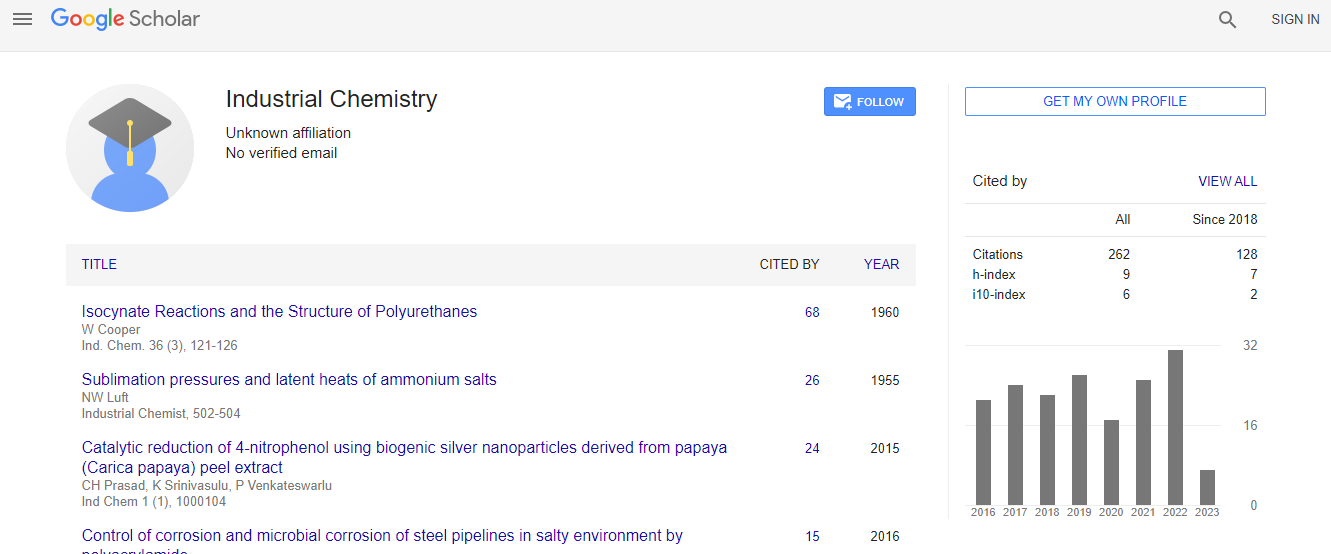Our Group organises 3000+ Global Conferenceseries Events every year across USA, Europe & Asia with support from 1000 more scientific Societies and Publishes 700+ Open Access Journals which contains over 50000 eminent personalities, reputed scientists as editorial board members.
Open Access Journals gaining more Readers and Citations
700 Journals and 15,000,000 Readers Each Journal is getting 25,000+ Readers
Google Scholar citation report
Citations : 262
Industrial Chemistry received 262 citations as per Google Scholar report
Indexed In
- Index Copernicus
- Google Scholar
- RefSeek
- Directory of Research Journal Indexing (DRJI)
- Hamdard University
- EBSCO A-Z
- OCLC- WorldCat
- Scholarsteer
- Geneva Foundation for Medical Education and Research
- Euro Pub
Useful Links
Recommended Journals
Related Subjects
Share This Page
Application of mesoporous materials to hydrogenation and Bayer Villiger oxidation of citral
International Conference on Industrial Chemistry
Izabela Nowak and Agnieszka Feliczak-Guzik
Adam Mickiewicz University in Poznan, Poland
Posters & Accepted Abstracts: Ind Chem
Abstract
This work focus on hydrogenation and Baeyer-Villiger oxidation of citral using mesoporous materials such as: MCM-41, SBA-12 and SBA-16 containing niobium, tin and/or ruthenium. The aim of our study was to test and evaluate several aspects of a catalyst. Combination of different support materials and active sites should lead to the desired products selectively and in high yield. All of the synthesized mesoporous molecular sieves were active catalysts for the Baeyer-Villiger oxidation of citral. The results of this reaction showed that 2-hydroxy-2,4-dimethyl-hept-6-en-3-one is the main product, followed by cyclocitral (├?┬▒,├?┬▓-unsaturated aldehyde) and dihydromyrcenol. The best results obtained for NbSBA-12 (yield around 25%) in ethanol as reaction medium at 323K and SnSBA-12 at 373K in ethanol as reaction medium (yield ~ 20%). In hydrogenation of citral the influence of pressure, time of reaction, temperature, composition and structural/textural properties of the obtained materials on the conversion of citral to the desired products was determined. It was observed that the conversion of citral increased with temperature and pressure reaction alterations. The hydrogenation selectivity depends on reaction temperature, i.e., at high temperature the selective hydrogenation of the C=O group was much more difficult in the presence of C=C bond. The product of the first hydrogenation step, citronellal, was isomerized to isopulegol on the acid sites and further hydrogenated to menthol at longer reaction times. The increase in the polarity of the solvent increases the catalytic activity, however the reaction pathway was modified.Biography
Izabela Nowak is a Professor at the Faculty of Chemistry, Adam Mickiewicz University in Poznan (AMU). She wrote her MSc thesis at the University of Reading (UK), where she was granted a scientific fellowship within TEMPUS. She received a DSc degree from AMU, whereas Postdoctoral training at the University of Liverpool (industrial grant). She stayed at the Kent State University (OH, USA) as a Fulbright Senior Fellow (2003) and Ko├?┬?ciuszko Foundation Grantee (2007). The American Chemical Society recognized her in 2011 as "Distinguished Women in Chemistry/Chemical Engineering". The total number of her publications in peer-reviewed journals is more than 70.
Email: nowakiza@amu.edu.pl

 Spanish
Spanish  Chinese
Chinese  Russian
Russian  German
German  French
French  Japanese
Japanese  Portuguese
Portuguese  Hindi
Hindi 